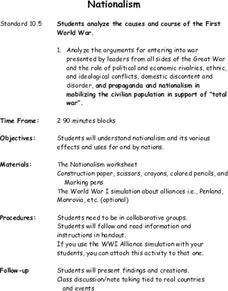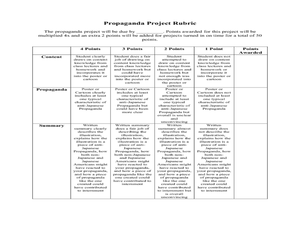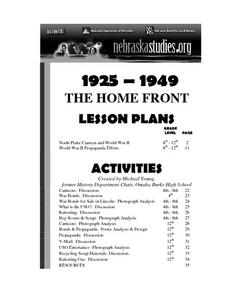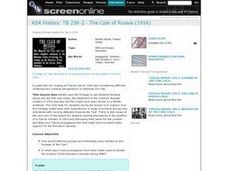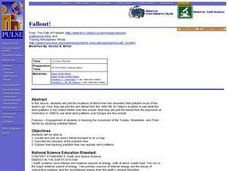Curated OER
Double V Campaign: Victory at Home and Victory Abroad
Students write a persuasive essay as if they were an African American in World War II and decide if they would contribute war bonds or not. In this World War II lesson plan, students study the segregation of World War II and the unity...
Curated OER
Iwo Jima: Forgotten Valor
Students explore the nature of island combat on Iwo Jima during World War II. They examine the association between the Pacific Theater of World War II and Iwo Jima. Students evaluate Charles Lindberg's oral history, propaganda posters,...
Curated OER
Nationalism
Tenth graders examine the causes and course of World War I. They read and discuss a handout, simulate the formation of a country, design a flag, develop a national slogan, and present their country's information to the class.
Curated OER
Japanese American Internment: Examining Racial Tensions
High schoolers discover how racial tension led to Japanese Internment. For this World War II lesson, students analyze political cartoons and posters related to the movement of Japanese-Americans to internment camps in the wake of the...
Curated OER
North Platte Canteen and World War II
Students employ primary resources to investigate the rise and decline of a canteen in World War II. The significance of volunteerism and the use of the railroad for troop transportation are examined.
Curated OER
The Holocaust
Eighth graders consider how something like the Holocaust could happen. In this Holocaust lesson, 8th graders analyze German propaganda that was used to garner support for World War II. Students discuss which pieces of propaganda were the...
Curated OER
Brave New World
Students view a video about the effects of World War II on the map of Europe. They discuss the video and answer questions. They work together to identify accomplishments that best represent American culture.
Museum of Tolerance
Developing Media Literacy
To protect young people from questionable content, many schools limit access. This resource suggests that because learners can so readily avail themselves to unrestricted Internet access, it is vital for 21st century learners to develop...
Curated OER
Writing About Pearl Harbor
Students summarize the reasons why the U.S. entered World War 2. They view a video on the bombing of Pearl harbor, construct a timeline of WWII events, and evaluate propaganda posters to create their analysis of the start of U.S....
Curated OER
Selling Warfare - Propaganda Posters
Students examine the use and purpose of propaganda posters during World War I. They work in groups to create a propaganda poster supporting a nation's war effort.
EngageNY
Building Background Knowledge: The Internment of Japanese-Americans during WWII, Part 4
Learners use a Analyzing Mediums handout to detail the advantages and disadvantages of communicating with mediums such as artwork, photographs, and political cartoons in the Japanese-American Internment during World War II primary...
Curated OER
Mexican Cessation
Eighth graders create a propaganda poster. In this US history lesson students research the various sides during the Mexican-American War. They present their poster and their position for or against the war.
Curated OER
World War II Multimedia Newscast: History, Technology, Journalism
Pupils compose a multi-media newscast on various subjects relating to WWII to demonstrate their knowledge and ability to research.
Curated OER
Art Imitates Life
Elementary and middle schoolers examine postcards depicting World War I events. Eventually, they create prints that reflect their own lives. In an interesting blend of history and current events, this instructional activity should engage...
Curated OER
WW II Magazine
Eleventh graders search the database for pictures of WW II, photographs, posters, etc. They use the documents to support writing two magazine articles. The magazine articles be a minimum of 500 and maximum 1000 words.
Stanford University
Philippine-American War Political Cartoon
Students investigate the Philippine War. In this propaganda lesson, students read the a timeline of events during the Philippine War. Students evaluate Philippine propaganda cartoons from the period.
Curated OER
WWI and Russian Revolution
Students view and discuss footage of Tsar Nicholas II reviewing troops on the Eastern Front in 1916 and examine how different groups would have reacted to this footage of the Tsar. They watch the video and in small groups answer...
Alabama Department of Archives and History
Yellow Journalism
What role did yellow journalism play in bringing the United States into war with Spain? As part of their study of the Spanish-American War, class groups examine newspapers of the times and other texts and then produce their own...
Curated OER
World War Ii - Japanese American Internment
Ninth graders determine that nationality is not defined by race, especially in the United States. They group into teacher created dyads with eight pictures. Four pictures are of American citizens (multiracial representations), and...
Curated OER
Art and Patriotic Culture
Art forms, especially government-sponsored "poster art", very effectively conveyed specific cultural values during World War II. Understanding the role that visual images play in expressing issues and ideas is critical to developing...
Curated OER
Fallout
High schoolers view a short film about the results of dropping the atomic bomb at the end of World War II. They research controversies surrounding the use of the bomb and nuclear weapons. They write two editorials about the issue.
Curated OER
The Diary of Anne Frank: Research Project on Concentration Camps during World War II
Eighth graders investigate the Holocaust and the persecution of specific ethnic groups in Europe during World War II.
Curated OER
Adolf Hitler: Was Hitler a Passionate Lunatic?
Young scholars investigate WWII by researching Adolf Hitler. In this dictator biographical lesson, students identify the role Adolf Hitler played in the self destruction of Germany by reading secret transcripts from German leaders. Young...
Curated OER
What Was the Cold War?
A study of the Cold War can helps students learn about history through interviewing people who lived through this period.




